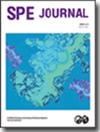边钻井边测井 Laterolog 与电磁波传播测量:哪种方法能反映真实的电阻率?
IF 3.2
3区 工程技术
Q1 ENGINEERING, PETROLEUM
引用次数: 0
摘要
在高角度油井中,经常使用边钻边测井(LWD)工具进行电磁传播(EMP)测量,这种测量方法对几何效应很敏感,可能会掩盖真实的地层电阻率。不常用的 LWD laterolog 测量有时被认为提供的数据太浅,无法提供真实的地层电阻率 (Rt)。在本文中,我们通过建模和实际案例来证明,在地层评估中,红土反射仪通常能提供比 LWD EMP 工具更好的电阻率测量结果。我们在几口穿越碳酸盐岩地层的高角度油井中,以 8.5 英寸和 6.125 英寸的孔径对红土反射仪和 EMP 电阻率进行了研究。在 8.5 英寸井段,对产水井和注水井(高电阻率和低电阻率范围)进行了评估。在 6.125 英寸井段,对夹在两个电阻率非常高的地层之间的一个储层和高度断裂储层中的另一个井眼进行了研究。通过对记忆数据进行一维反演,对侧向数据进行了入侵校正。使用基于结构的前向建模来检查和解释侧向和电磁脉冲电阻率测量之间的差异。在第一个例子中,在一个厚的低电阻率储层中,红外成像电阻率与电磁脉冲电阻率一致,表明在没有几何效应的情况下,这两种工具提供了相同的测量结果。在第二个示例的第一部分,最初仅使用 LWD EMP 电阻率测量钻探储层区。几天后进行了 LWD 后验,与 EMP 电阻率相比,重新记录的部分电阻率数据读数要低得多。由于在数天内发生了过深的入侵,因此侧向一维反演无法解析 Rt。在第二个例子的第二部分,红土电阻率显示了明显的导电入侵剖面。虽然最深的红外实时电阻率数据显示电阻率低于电磁脉冲电阻率,但真实的电阻率 Rt(入侵校正后的一维反演红外电阻率)与电磁脉冲 Rt 电阻率相吻合。这一结果验证了两个测量结果,并强调差异是由入侵造成的。前两个例子表明,在正常钻井条件下(钻井后 1-2 小时内),即使存在侵入,侧向仪测量也能提供未受侵入的地层电阻率。另一个例子中的储层夹在电阻层之间,导致电磁脉冲电阻率读数升高,难以解释。结构建模再现了电磁脉冲数据的升高行为,并解释了电阻率测量值之间的差异。这一结果表明,在与相邻层存在高电阻率对比的薄储层中,红外成像技术更适合评估电阻率。最后,本文介绍了一些断裂储层实例,这些实例表明,裂缝群的存在会对红外成像法和电磁脉冲法产生影响。本文介绍的实例表明,在高角度油井中,在正常钻井条件下获得的入侵校正侧向电阻率往往比 EMP 电阻率更接近 Rt。在这种情况下,红土电阻率测量提供的数据可以更好地用于水饱和度计算。来自高角度油井的多个实例说明了这一发现。本文章由计算机程序翻译,如有差异,请以英文原文为准。
Logging-While-Drilling Laterolog vs. Electromagnetic Propagation Measurements: Which Is Telling the True Resistivity?
The electromagnetic propagation (EMP) measurement frequently acquired with logging-while-drilling (LWD) tools in high-angle wells is sensitive to geometrical effects that can mask the true formation resistivity. Less commonly used, the LWD laterolog measurement is sometimes perceived as providing data too shallow to give a true formation resistivity (Rt). In this paper, we presents modeling and actual examples to demonstrate that the laterolog can often provide a superior resistivity measurement for formation evaluation to that of the LWD EMP tool.
We examine the laterolog and EMP resistivities in several high-angle wells crossing carbonate formations in 8.5-in. and 6.125-in. hole sizes. In the 8.5-in. sections, producers and water injectors (high- and low-resistivity ranges) were evaluated. In the 6.125-in. sections, one reservoir sandwiched between two very high-resistivity layers and another borehole in a highly fractured reservoir were examined. The laterolog data were corrected for invasion using a 1D inversion of the memory data. Structure-based forward modeling was used to examine and explain the differences between the laterolog and EMP resistivity measurements.
In the first example in a thick low-resistivity water reservoir, laterolog resistivity and EMP resistivity agree, showing that the two tools provide the same measurement when no geometrical effects are present.
In the first part of the second example, a reservoir zone was initially drilled only with the LWD EMP resistivity measurement. The LWD laterolog was run several days later, and the resistivity data read much lower in the relogged section compared with the EMP resistivity. The laterolog 1D inversion was unable to resolve Rt because of the excessively deep invasion that occurred over the course of several days.
In the second part of the second example, the laterolog resistivity showed a clear conductive invasion profile. While the deepest laterolog real-time resistivity data indicated lower resistivity than the EMP resistivity, the true resistivity, Rt (invasion-corrected 1D-inverted laterolog resistivity), matched the EMP Rt resistivity. This result validated both measurements and emphasized that the differences were due to invasion.
The first two examples demonstrated that when acquired in normal drilling conditions (within 1–2 hours of drilling the section), the laterolog measurements can provide uninvaded formation resistivity even in the presence of invasion.
A reservoir in another example was sandwiched between resistive layers that caused difficult-to-explain elevated EMP resistivity readings. Structural modeling reproduced the elevated behavior of the EMP data and explained the differences between resistivity measurements. This result showed that the laterolog is better suited to evaluate resistivity in thin reservoirs where there is a high-resistivity contrast to the adjacent layer.
Finally, fractured reservoir examples are presented, which show that both the laterolog and EMP can be affected by the presence of fracture swarms.
The examples presented in this paper demonstrate that in high-angle wells, when acquired under normal drilling conditions, invasion-corrected laterolog resistivity is often nearer to Rt than EMP resistivity. In those cases, the laterolog measurement provides data that are better inputs to water saturation calculations. Multiple examples from high-angle wells illustrate the findings.
求助全文
通过发布文献求助,成功后即可免费获取论文全文。
去求助
来源期刊

SPE Journal
工程技术-工程:石油
CiteScore
7.20
自引率
11.10%
发文量
229
审稿时长
4.5 months
期刊介绍:
Covers theories and emerging concepts spanning all aspects of engineering for oil and gas exploration and production, including reservoir characterization, multiphase flow, drilling dynamics, well architecture, gas well deliverability, numerical simulation, enhanced oil recovery, CO2 sequestration, and benchmarking and performance indicators.
 求助内容:
求助内容: 应助结果提醒方式:
应助结果提醒方式:


